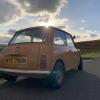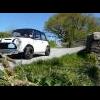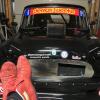In general terms the aerodynamic drag increases as the square of the speed.
I know it is an over-simplification, but a standard 850 Mini with 35 bhp used to max out at 70 mph. Therefore, if the speed were to be doubled, i.e. multiplied by 2, to 140 mph, the drag would be 2 squared (= 4) and thus the power would need to be 4 x 34 which is 136 bhp.
There are other factors in play here as gearing will be critical, but peak power would need to be at 140 mph. The engine would need to be very high-revving, so if peak power was at say, 7000 rpm, the gearing would need to be 20 mph/1000 rpm in top. The problem then is the spacing of the gears and the ability of the power/torque curve to pull through the rev range without 'bogging down' when changing up.
The drag can best be reduced by removing the huge wing mirrors, running 145 section tyres on narrow wheels, removing the wheel arch extensions and plating under the rear sub-frame each side of the exhaust (centre-exit of course to do this).
The drag increase will not be to an x = y squared graph as ground-effects will come into play and there may be other minor factors (are the windows closed, for example).

















